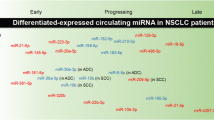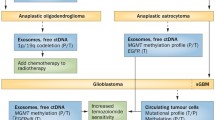Highly malignant glial tumors (highly malignant gliomas) are the most aggressive primary brain neoplasms. Understanding of the pathogenesis and development of new and effective diagnostic and therapeutic methods is therefore of great interest. MicroRNAs are short noncoding RNA molecule of length 18–22 nucleotides which have been shown to play a direct role in carcinogenesis. Circulating microRNA are released into the extracellular space and can remain stable for long periods of time in most biological fluids, including serum and plasma. Circulating microRNA are potential biomarkers for different expression profiles specific for different human diseases, including oncological diseases. Many data have been obtained showing that different circulating microRNA profiles in human biological fluids particularly in extracellular vesicles, are linked with numerous neoplastic processes, such that microRNA may constitute a new class of biomarkers for early diagnosis and prognosis of highly malignant gliomas.
Similar content being viewed by others
References
J. A. Schwartzbaum, J. L. Fisher, K. D. Aldape, and M. Wrensch, “Epidemiology and molecular pathology of glioma,” Nat. Clin. Pract. Neurol., 2, 494–503 (2006), https://doi.org/10.1038/ncpneuro0289.
N. Mutter and R. Stupp, “Temozolomide: a milestone in neurooncology and beyond?” Expert Rev. Anticancer Ther., 6, 1187–204 (2006), https://doi.org/10.1586/14737140.6.8.1187.
R. Stupp, M. E. Hegi, W. P. Mason, et al., “Effects of radiotherapy with concomitant and adjuvant temozolomide versus radiotherapy alone on survival in glioblastoma in a randomized phase III study: 5-Year analysis of the EORTC-NCIC trial,” Lancet Oncol, 10, 459–466 (2009), https://doi.org/10.1016/S1470-2045(09)70025-7.
D. MicroRNA as potential, L. Stalpers, W. Taal, et al., “Clinical features, mechanisms, and management of pseudoprogression in malignant gliomas,” Lancet Oncol, 9, 453–461 (2008), https://doi.org/10.1016/S1470-2045(08)70125-6.
S. A. MacLellan, C. MacAulay, S. Lam, and C. Garnis, “Pre-profi ling factors influencing serum microRNA levels,” BMC Clin. Pathol., 14, 27–38 (2014), https://doi.org/10.1186/1472-6890-14-27.
P. Roth, J. Wischhusen, C. Happold, et al., “A specifi c miRNA signature in the peripheral blood of glioblastoma patients,” J. Neurochem., 118, 449–457 (2011), https://doi.org/10.1111/j.1471-4159.2011.07307.x.
D. N. Louis, A. Perry, G. Reifenberger, et al., “The 2016 World Health Organization Classification of Tumors of the Central Nervous System: a summary,” Acta Neuropathol., 131, 803–820 (2016),https://doi.org/10.1007/s00401-016-1545-1.
Z. Areeb, S. S. Stylli, R. Koldej, et al., “MicroRNA as potential biomarkers in glioblastoma,” J. Neurooncol., 125, 237–248 (2015), https://doi.org/10.18632/oncotarget.14445.
X. Ye, W. Wei, Z. Zhang, et al., “Identifi cation of microRNAs associated with glioma diagnosis and prognosis,” Oncotarget, 8, 26394–26403 (2017), https://doi.org/10.18632/oncotarget.14445.
M. Westphal and K. Lamszus, “Circulating biomarkers for gliomas,” Nat. Rev. Neurol., 11, 556–566 (2015), https://doi.org/10.1038/nrneurol.2015.171.
Y. He, J. Lin, D. Kong, et al., “Current state of circulating microRNAs as cancer biomarkers,” Clin. Chem., 61, 1138–1155 (2015), https://doi.org/10.1373/clinchem.2015.241190.
J. R. Chevillet, J. Lee, H. A. Briggs, et al., “Issues and prospects of microRNA-based biomarkers in blood and other body fl uids,” Molecules, 19, 6080–6105 (2014), https://doi.org/10.3390/molecules19056080.
N. Kosaka, Y. Yoshioka, Y. Fujita, and T. Ochiya, “Versatile roles of extracellular vesicles in cancer,” J. Clin. Invest., 126, 1163–1172 (2016), https://doi.org/10.1172/JCI81130.
R. Kalluri, “The biology and function of exosomes in cancer,” J. Clin. Invest., 126, 1208–1215 (2016), https://doi.org/10.1172/JCI81135.
J. Skog, T. Wurdinger, S. van Rijn, et al., “Glioblastoma microvesicles transport RNA and proteins that promote tumour growth and provide diagnostic biomarkers,” Nat. Cell Biol., 10, 1470–1476 (2008), https://doi.org/10.1038/ncb1800.
C. Villarroya-Beltri, C. Gutierrez-Vazquez, F. Sanchez-Cabo, et al., “Sumoylated hnRNPA2B1 controls the sorting of miRNAs into exosomes through binding to specifi c motifs,” Nat. Commun., 4, 2980–2990 (2013), https://doi.org/10.1038/ncomms3980.
G. Regazzo, I. Terrenato, M. Spagnuolo, et al., “A restricted signature of serum miRNAs distinguishes glioblastoma from lower grade gliomas,” J. Exp. Clin. Cancer Res., 35, 124–135 (2016), https://doi.org/10.1186/s13046-016-0393-0.
J. M. Figueroa and B. S. Carter, “Detection of glioblastoma in biofluids,” J. Neurosurg., 129, No. 2, 334–340 (2018), https://doi.org/ https://doi.org/10.3171/2017.3.JNS162280.19.
T. Siegal, H. Charbit, I. Paldor, et al., “Dynamics of circulating hypoxia-mediated miRNAs and tumor response in patients with highgrade glioma treated with bevacizumab,” J. Neurosurg., 125, 1008–1015 (2016), https://doi.org/10.3171/2015.8.JNS15437.
C. A. Tumilson, R. W. Lea, J. E. Alder, and L. Shaw, “Circulating MicroRNA biomarkers for glioma and predicting response to therapy,” Mol. Neurobiol., 50, 545–558 (2014), https://doi.org/10.1007/s12035-014-8679-8.
S. Jia, D. Zocco, M. L. Samuels, et al., “Emerging technologies in extracellular vesicle-based molecular diagnostics,” Expert Rev. Mol. Diagn., 14, 307–321 (2014), https://doi.org/10.1586/14737159.2014. 893828.
S. M. Evans, M. Putt, X. Y. Yang, et al., “Initial evidence that bloodborne microvesicles are biomarkers for recurrence and survival in newly diagnosed glioblastoma patients,” J. Neurooncol., 127, 391–400 (2016), https://doi.org/10.1007/s11060-015-2051-3.
Y. H. Feng and C. J. Tsao, “Emerging role of microRNA-21 in cancer (Review),” Biomed. Rep., 5, 395–402 (2016), https://doi.org/10. 3892/br.2016.747.
L. Manterola, E. Guruceaga, J. G. Perez-Larraya, et al., “A small noncoding RNA signature found in exosomes of GBM patient serum as a diagnostic tool,” Neuro Oncol., 16, 520–527 (2014), PMID: 24435880, https://doi.org/10.1093/neuonc/not218.
A. Turchinovich, L. Weiz, A. Langheinz, and B. Burwinkel, “Characterization of extracellular circulating microRNA,” Nucleic Acids Res., 39, 7223–7233 (2011), https://doi.org/10.1093/nar/gkr254.
Q. Wang, P. Li, A. Li, et al., “Plasma specifi c miRNAs as predictive biomarkers for diagnosis and prognosis of glioma,” J. Exp. Clin. Cancer Res., 31, 97–107 (2012), https://doi.org/10.1186/1756-9966-31-97.
P. Ivo D’Urso, O. F. Urso, and C. D. Gianfreda, “MiR-15b and miR-21 as circulating biomarkers for diagnosis of glioma,” Curr. Genomics, 16, 304–311 (2015), https://doi.org/10.2174/138920291 6666150707155610.
R. Zhang, B. Pang, T. Xin, et al., “Plasma miR-221/222 family as novel descriptive and prognostic biomarkers for glioma,” Mol. Neurobiol., 53, 1452–1460 (2016).
F. Zhi, N. Shao, R. Wang, et al., “Identifi cation of 9 serum microRNAs as potential noninvasive biomarkers of human astrocytoma,” Neuro Oncol., 17, 383–391 (2015), https://doi.org/10.1093/neuonc/nou169.
N. S. Lai, D. Wu, X. Fang, et al., “Serum microRNA-210 as a potential noninvasive biomarker for the diagnosis and prognosis of glioma,” Br. J. Cancer, 112, 1241–1246 (2015), https://doi.org/10.1038/bjc.2015.91.
J. Wu, L. Li, and C. Jiang, “Identification and evaluation of serum microRNA-29 family for glioma screening,” Mol. Neurobiol., 52,1540–1546 (2015), https://doi.org/10.1007/s12035-014-8937-9.
Author information
Authors and Affiliations
Corresponding author
Additional information
Translated from Zhurnal Nevrologii i Psikhiatrii imeni S. S. Korsakova, Vol. 119, No. 5, Iss. 1, pp. 86–90, May, 2019.
Rights and permissions
About this article
Cite this article
Gareev, I.F., Novicova, L.B. & Beylerli, O.A. Circulating MicroRNA as Novel Potential Biomarkers for the Diagnosis of Highly Malignant Gliomas. Neurosci Behav Physi 50, 283–287 (2020). https://doi.org/10.1007/s11055-020-00899-x
Received:
Accepted:
Published:
Issue Date:
DOI: https://doi.org/10.1007/s11055-020-00899-x




